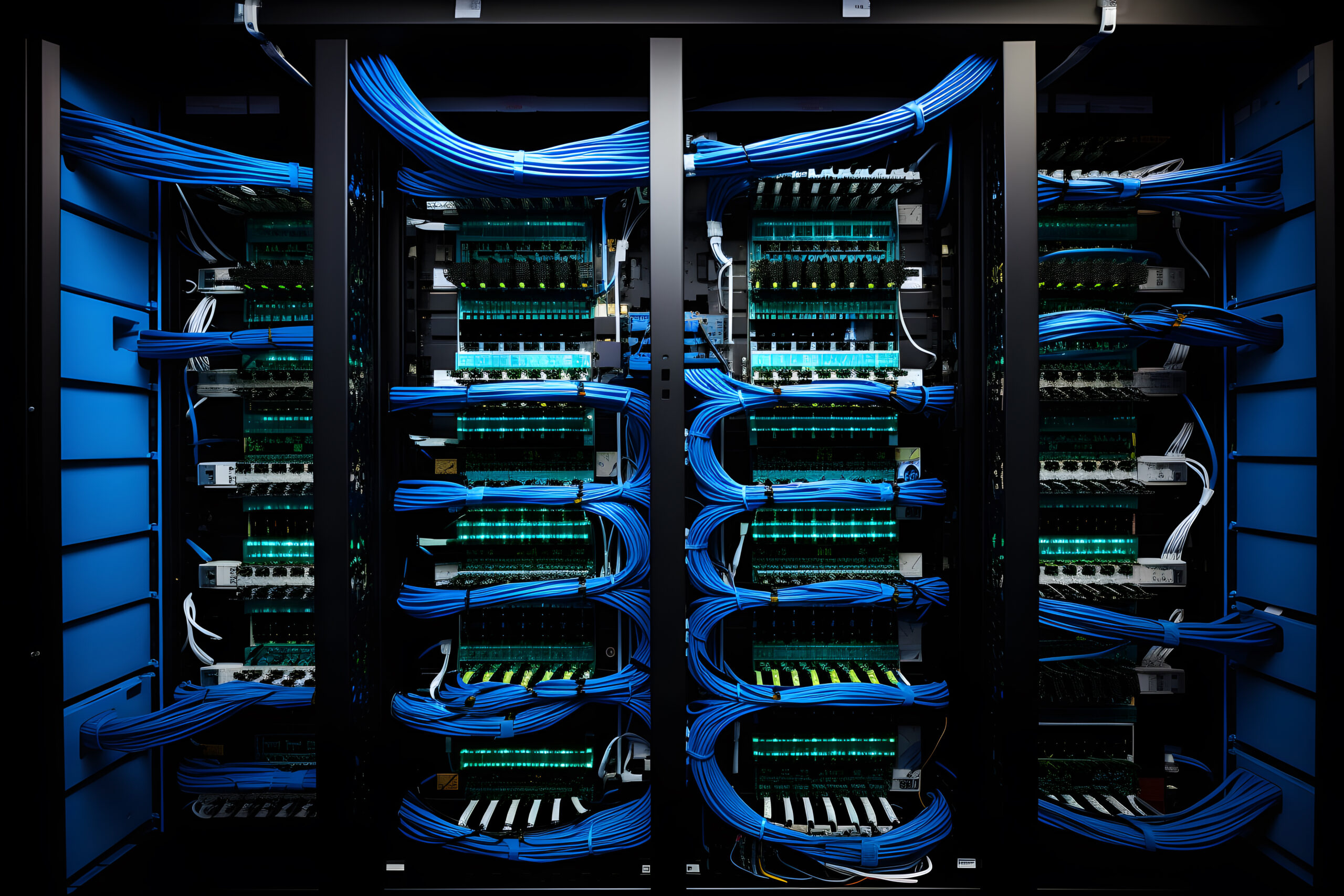Structured cabling is the backbone of any robust IT infrastructure, designed to support the seamless operation and management of highly sophisticated systems across modern businesses. This wiring framework standardizes the entire IT infrastructure to enhance system efficiency and scalability, supporting a wide range of telecommunications services including data transmission, phone services, and security systems. The modular nature of structured cabling not only simplifies troubleshooting and maintenance but also facilitates future upgrades, essential for keeping pace with technological advancements.
The system comprises six main components, each integral to the network's overall functionality and performance. By understanding these components—from the cables that connect individual devices to the infrastructure supporting entire buildings—businesses can optimize their IT structured cabling systems for reliability and performance. This guide provides a clear overview of these components, their roles, challenges in implementation, and the emerging trends that are shaping the future of structured cabling systems.
The 6 Components of Structured Cabling
1. Horizontal Cabling
Horizontal cabling connects individual outlets or workstations to the central telecommunications rooms within the same floor, essentially serving as the local traffic lanes for data, voice, and multimedia communications. It is critical for daily network operations and directly impacts end-user connectivity and experience.
Cable Types Commonly Used: Typically, CAT5e, CAT6, and CAT6a cables are employed in horizontal cabling due to their ability to support high-speed data transmission and their durability.
Best Practices for Installation and Maintenance: Ensuring no cable exceeds the maximum recommended length of 100 meters to avoid data loss and adhering to proper installation codes to minimize interference and enhance connectivity.
2. Vertical Cabling (Backbone Cabling)
Backbone cabling is what connects different floors or even buildings within a campus, ensuring that data flows smoothly across the physical space of an enterprise. This includes not only the cables themselves but also associated hardware like routers, switches, and muxes that manage data pathways.
Types of Cables Employed: Fiber optic cables and high-grade copper cables like CAT6a and CAT7 are commonly used for backbone cabling to ensure high-speed data transfer over long distances with minimal signal loss.
Considerations for Designing a Robust System: Proper planning to accommodate future expansions and the use of scalable cable management systems are crucial for a successful vertical cabling setup.
3. Work Area Components
Work area components are what the end-users interact with; these include cabling patch cords, station outlets, and adapters. These components need to be flexible and user-friendly to accommodate varying needs and configurations of workstations.
Types of Components: Includes patch cables, connectors, faceplates, and workstation outlets that need to be easy to use and flexible.
Ensuring Proper Connectivity and Accessibility: Organizing components in a manner that allows easy access for maintenance and future upgrades is essential.
4. Telecommunications Room (TR)
A telecommunications room (TR) serves as a mini hub within a building, distributing IT services from the equipment room to various end-points. This room contains the equipment necessary to manage and route communications throughout the building.
Design Principles: Efficiently designed TRs should minimize cable length and optimize space for equipment and cable management, enhancing overall system reliability.
Security and Maintenance Considerations: Secure access to telecommunications rooms is crucial, as is regular maintenance to ensure all components function optimally.
5. Equipment Room
The equipment room is the central point where major networking equipment is located, including servers, switches, and routers. It is critical for the centralized management of IT resources and often serves as the connection point for backbone and horizontal cabling.
Key Components and Layout Considerations: Space planning should account for both current needs and potential expansions. Airflow management and environmental controls are critical to protect equipment from overheating.
Ensuring Scalability and Flexibility: Modular design and scalable solutions allow for easy upgrades as technology advances or business needs grow.
6. Entrance Facilities
Entrance facilities are the points at which external telecommunications public networks connect with the building's internal network. They are critical for managing and protecting the interface between external and internal network infrastructures.
Importance of Proper Cable Management and Protection: Effective cable management systems protect cables from physical and environmental damage while ensuring compliance with national and international standards.
Compliance and Safety Considerations: Adhering to local codes and regulations is essential for ensuring safety and functionality in entrance facilities.

Common Challenges and How BCS Consultants Address Them
Inadequate Planning for Growth: Many businesses underestimate their growth and scalability needs, leading to cabling infrastructure that quickly becomes insufficient as demands increase.
Cable Management Issues: Poor cable management can lead to tangled wires, decreased airflow, and increased difficulty in troubleshooting and maintenance, affecting overall network performance.
Compatibility Issues: As new technologies emerge, existing cabling systems may struggle to support newer standards, resulting in performance bottlenecks.
Budget Constraints: Upfront costs for high-quality cabling and professional installation can be significant, often leading businesses to opt for lower-quality solutions that may cost more in the long run due to maintenance and upgrades.
Strategies for Addressing These Challenges
Future-Proofing Infrastructure: Utilizing flexible and high-capacity cabling options such as those offered by BCS Consultants, including advanced fiber optic solutions that cater to high-speed data requirements.
Effective Cable Management: Implementing structured cabling standards and using tools like sophisticated racking systems provided by BCS Consultants can greatly enhance the maintenance and scalability of network installations.
Regular Maintenance and Upgrades: BCS Consultants stresses the importance of routine inspections and the integration of new technologies to maintain system efficiency and adapt to new operational requirements.
Future Trends and Innovations
Emerging Technologies Shaping Structured Cabling
Increased Fiber Optic Adoption: The need for faster transmission speeds and higher bandwidth makes fiber optics critical. Solutions designed to meet these advanced needs ensure reliability and scalability.
Power Over Ethernet (PoE) Enhancements: As PoE technology continues to evolve, solutions that expand the utility of network cables to power a broader range of devices effectively are becoming more crucial.
Intelligent Infrastructure Management (IIM): Real-time monitoring capabilities through IIM systems help businesses proactively manage their network performance and cabling infrastructure.

Conclusion
Effectively addressing the challenges in structured cabling systems requires a combination of strategic planning, meticulous management, and ongoing compliance efforts. By understanding the common pitfalls and applying these strategies, businesses can build resilient IT infrastructures that support current operations and are prepared for future technological developments.
This comprehensive approach not only enhances the functionality and efficiency of the network but also positions the organization for smooth scalability and adaptability in the face of evolving IT demands.
Ready to Optimize Your Network Infrastructure in California/Orange County?
Explore our advanced structured cabling solutions, tailored for businesses in California. From robust fiber optics to efficient cable management systems, we ensure your IT infrastructure is prepared for today and scalable for tomorrow. Our structured wiring expertise guarantees enhanced network performance and reliability. Call us today at +1 949-333-1000 or visit our website to learn how our services can improve your business connectivity. Act now to optimize your infrastructure!
FAQs
1. What is structured cabling and why is it important for my business?
A: Structured cabling is an organized approach to cabling infrastructure that supports multiple hardware uses and is centrally managed. It is crucial for businesses as it ensures reliable connectivity, scalability, and easier maintenance, which can significantly improve network performance and operational efficiency.
2. How does BCS Consultants enhance traditional structured cabling systems?
A: BCS Consultants enhances structured cabling systems with advanced solutions like high-capacity fiber optics, comprehensive racking and cable management systems, and intelligent infrastructure management. These improvements support high-speed data transfer, increase system durability, and facilitate future upgrades.
3. What are some future trends in structured cabling I should be aware of?
A: Future trends in structured cabling include the increased use of fiber optic technology for faster data transmission, advancements in Power Over Ethernet (PoE) to support more devices, and the integration of intelligent infrastructure management systems for real-time monitoring and proactive system maintenance. BCS Consultants stays ahead of these trends, ensuring that your cabling infrastructure is not only up-to-date but also future-ready.


You must be logged in to post a comment.